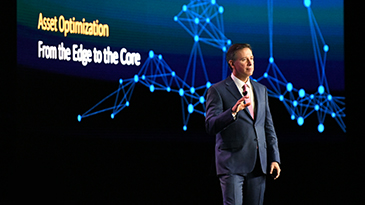Digital transformation is already a proven value creator at some process industry organizations, including many in upstream, downstream and chemicals. It is a strong driver of growth and change, as evidenced by results like these:
-
ENI attributes significant gains in time-to-first-gas and -oil to its use of digital technologies.
-
A BPCL refinery in Mumbai, India has improved sustainability metrics and reduced emissions.
-
ADNOC in UAE has reduced water use asset-wide.
-
A major U.S. refiner reports gaining a multimillion dollar advantage in less than one year from machine learning-based prescriptive maintenance.
This is all just a beginning.
However, a group I call the “frozen middle” is creating friction and slowing down progress at many asset-intensive companies. The “frozen middle” is, collectively, the middle managers — the functional leaders in these companies, most of whom have decades of experience. They are used to working at a careful pace. They are used to analyzing many factors before committing company capital. They are used to the control they have earned through flawless, but conservative, execution over several decades.
But the landscape is shifting and moving under their feet. There are upheavals economically, geopolitically and technologically. The pace of everything has picked up.
Executives know this; they are hearing it from the global consultancies. They see how behemoths in other industries have lost major ground to technologically immersed, small, disruptive competitors. They ponder whether it can happen in oil and chemicals. They want to act.
The young workforce believe this. They use disruptive technologies. They are comfortable with data-driven applications that govern many of their personal decisions. They are eager to apply innovation In their work place.
The consequence, in some of the largest enterprises in the world, is the executives bypassing traditional leadership hierarchies and assigning key digital technology adoption roles to emerging leaders from the ranks of young, technically sophisticated newcomers to their companies. They have titles like “digital evangelist,” and they are given the resources to try many things out.
My message is for the functional leaders, though. You are the ones who are really crucial to this all taking hold and actually working. The functional leaders can empower these new digital evangelists. You can help them gain credibility in operating environments. You can help meld decades of experience with enthusiasm and the prodigious power of new technologies. You can help the digital evangelists penetrate the factory floor.
Alignment for Digital Transformation
Alignment is crucial. The innovators, the implementors of digital innovation in your company, need your support as operational leaders. Without your experience and support, they won’t get the enthusiasm and commitment of Operations.
In the oilfield, in the plant and in the maintenance crew, experience matters. Your credibility as experienced operators will be crucial in getting the digital initiatives focused on the right problems, solving the right problems and bought into by the “grizzled operators.”
I’ve seen this play out multiple times over the past year. It is the alignment of the sponsoring executive, the committed and visionary operational leader and the creative and agile digital technologist that gets the attention of the asset operators and makes it succeed.
In all of the examples that I cited at the top of this post (and many more), it is this partnership of innovators with domain expertise and experience, along with the alignment to solve a challenge with business value, that makes it all work.
Five Ways to Drive Innovation
It’s the people and the agile organization that position digital technology to transform and bring renewed competitive advantage to an organization. So how can you, as an operational leader, pivot to become the catalyst of innovation that will vault your organization to the forefront of digital transformation in process manufacturing? Here are some tips:
- Relentlessly focus on areas of operational excellence such as plant uptime, asset utilization and asset optimization. By focusing on measurable business value, you secure wins that create momentum across an organization to try new things. (BPCL has done this, with over 30 projects, each of which is tied to a particular outcome.)
-
“Democratize” your decision-making. Actionable data, and its implications for an organization’s achievement of key business objectives, is driven down to all levels in an organization. Adapt your organizational style to recognize this flatter, more distributed, more agile way of making small and large decisions. An example is sustainability, where the impact of every decision on asset energy and water use can be made transparent to every worker, motivating them to make operating decisions bearing those key metrics in mind. (ADNOC has done this with an upstream asset, resulting in reduction in water use.)
-
Act — don’t analyze! The results may surprise you. A global refiner embarked on a journey to apply new dynamic optimization technology, which ties refinery planning to operational advanced control in a far reaching manner. The effort not only improved diesel production over 10% in one of their largest refineries, but it also identified an operating strategy to exceed the believed throughput limits of the asset. This got the enthusiastic buy-in of the technical workers, as well as the experienced optimization engineers and operators.
-
Internalize and communicate that digital technology doesn’t replace operators or knowledge workers. It improves their work, it helps make better and faster decisions, and it ensures that decisions are the right ones in face of increasing complexity. The hidden barrier that creates friction is that staff are afraid that AI and machine learning will replace their jobs. In these complex assets, it can’t! It simply improves both business decision-making and safety.
-
And finally, start small. Pick the low-hanging fruit. We helped an oilfield operator implement a simple digital twin for a lift-gas compression train, and it took only weeks to put in place. They measured over $1 million in increased revenue in just one month. The success quickly spread across the global organization and spawned other, larger projects.
So leading asset operators worldwide are applying digital technologies, gaining alignment and achieving important business results in the areas of asset uptime, optimization and sustainability. But that’s really only possible, with the enthusiasm and leadership of the operational managers in an organization.
Don’t be part of the “frozen middle!” Be a key to alignment, agility and competitive advantage.
To learn how energy companies can transform to achieve new levels of operational excellence, check out our recent executive brief, Next-Generation Operational Technologies Enable the Smart Enterprise in a Changing World.






Leave A Comment